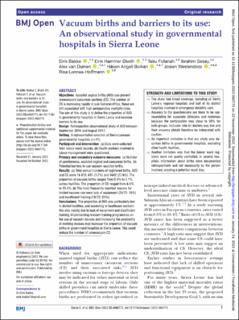| dc.contributor.author | Bakke, Eirik | |
| dc.contributor.author | Øseth, Eirik | |
| dc.contributor.author | Fofanah, Tairu | |
| dc.contributor.author | Sesay, Ibrahim | |
| dc.contributor.author | van Duinen, Aalke Johan | |
| dc.contributor.author | Bolkan, Håkon Angell | |
| dc.contributor.author | Westendorp, Josien | |
| dc.contributor.author | Lonnee-Hoffmann, Risa | |
| dc.date.accessioned | 2023-02-13T12:24:02Z | |
| dc.date.available | 2023-02-13T12:24:02Z | |
| dc.date.created | 2022-12-01T12:20:27Z | |
| dc.date.issued | 2022 | |
| dc.identifier.citation | BMJ Open. 2022, 12 (11), e060773-?. | en_US |
| dc.identifier.issn | 2044-6055 | |
| dc.identifier.uri | https://hdl.handle.net/11250/3050385 | |
| dc.description.abstract | Objectives Assisted vaginal births (AVD) can prevent unnecessary caesarean sections (CS). The number of CS is increasing rapidly in sub-Saharan Africa; these are still associated with high perioperative mortality rates. The aim of this study is to define the proportion of AVD in governmental hospitals in Sierra Leone and examine barriers to its use.
Design Retrospective observational study of AVD between September 2016 and August 2017.
Setting A representative selection of Sierra Leonean governmental hospitals (n=11).
Participant and intervention (a) Data were collected from labour ward records. (b) Health workers involved in labour management were questioned.
Primary and secondary outcome measures (a) Number of spontaneous, assisted vaginal and caesarean births. (b) Potential barriers to use vacuum-assisted births.
Results (a) Total annual numbers of registered births, AVD and CS were 16 833, 631 (3.7%) and 4642 (27.6%). The proportion of vacuum births ranged from 0.0% to 5.1% across facilities. The proportion of CS ranged from 6.5% to 33.4%. (b) The most frequently reported reasons for limited vacuum use were lack of equipment (25/72; 35%) and insufficient training (18/72; 25%).
Conclusions The proportion of AVD was particularly low in district facilities, and according to healthcare workers this was mostly due to lack of equipment and insufficient training. Implementing relevant training programmes on the use of vacuum devices and increasing the availability of working devices may increase the proportion of vacuum births in government hospitals in Sierra Leone. This could reduce the number of unnecessary CS. | en_US |
| dc.language.iso | eng | en_US |
| dc.publisher | BMJ Publishing Group | en_US |
| dc.rights | Navngivelse-Ikkekommersiell 4.0 Internasjonal | * |
| dc.rights.uri | http://creativecommons.org/licenses/by-nc/4.0/deed.no | * |
| dc.title | Vacuum births and barriers to its use: An observational study in governmental hospitals in Sierra Leone | en_US |
| dc.title.alternative | Vacuum births and barriers to its use: An observational study in governmental hospitals in Sierra Leone | en_US |
| dc.type | Peer reviewed | en_US |
| dc.type | Journal article | en_US |
| dc.description.version | publishedVersion | en_US |
| dc.source.volume | 12 | en_US |
| dc.source.journal | BMJ Open | en_US |
| dc.source.issue | 11 | en_US |
| dc.identifier.doi | 10.1136/bmjopen-2022-060773 | |
| dc.identifier.cristin | 2086977 | |
| cristin.ispublished | true | |
| cristin.fulltext | original | |
| cristin.qualitycode | 1 | |

